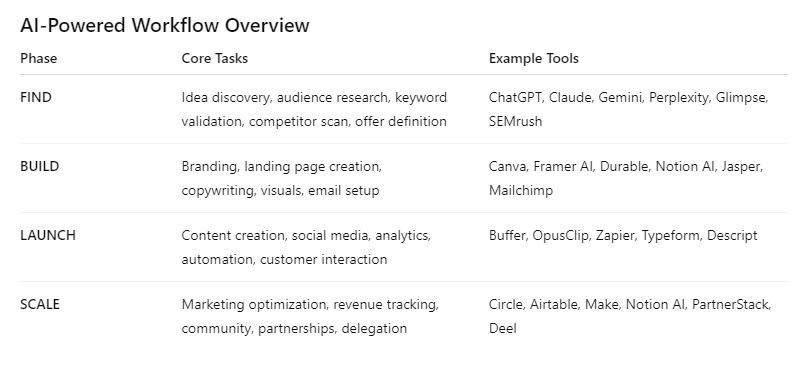How to Use AI to Boost (Not Replace) Your Side Hustle
A step-by-step breakdown of how to use AI tools to find, build, launch, and scale your side hustle — with real-world workflows and the best free vs. paid options.
What if your side hustle could run twice as fast — with half the effort?
That’s what AI makes possible today.
How can I use AI to find a profitable business idea?
Which tools actually help me save time instead of wasting it?
Can I really automate content, clients, or sales without sounding robotic?
The truth is that AI doesn’t replace your work — it amplifies it.
Used correctly, it gives solo founders and small business owners the same leverage once reserved for startups with entire teams.
In this article, we break down the four stages of a side business lifecycle — Find, Build, Launch, and Scale — and show how AI (and non-AI) tools fit into each one.
For every stage, we highlight:
What tasks to focus on, so you don’t spread yourself thin;
Which free and paid AI tools to use, and how to make them work together;
Real workflow examples, showing how modern creators, freelancers, and solopreneurs use AI as their silent partner.
Right below, you’ll find a snapshot table summarizing the 4 phases and the main categories of tools used in each — a visual map of how AI can streamline your growth journey.
Then, we go deep into each stage: from discovering your niche to automating operations and scaling revenue — showing you exactly how to turn AI from a buzzword into a growth engine.
The four phases:
Find — discover profitable ideas and real market demand.
Build — create fast prototypes, visuals, and assets.
Launch — promote, automate, and gather insights.
Scale — expand reach and revenue efficiently.
FAQ: Fast answers before we dive in
1. Can AI really help me start a side hustle from scratch?
Yes — AI can dramatically shorten the learning curve. From validating ideas to building prototypes and finding clients, it removes friction. But it’s not magic: you still need direction, testing, and human insight.
2. Do I need paid tools to get results?
Not necessarily. Many high-value tools (like ChatGPT, Notion AI, or Canva) have strong free tiers. The premium versions mostly add speed and integration. In each phase, we explain when paying actually makes sense.
3. What’s the best AI tool to start with?
Start with one large language model (ChatGPT, Claude, or Gemini) — it’s your Swiss Army knife. Then add one specialized tool per need: SEO, design, automation, or analytics. Simplicity scales better than complexity.
4. How do I avoid over-automating my business?
Automation should remove repetitive work, not human connection. Always keep control of customer-facing communication — let AI handle background tasks like scheduling, emails, or research.
5. Will AI make side hustles too competitive?
Competition increases, but differentiation matters more. The barrier to starting drops, but the barrier to standing out rises. Those who learn to use AI strategically — not just copy-paste prompts — will lead the next wave of solopreneurs.
6. Is this guide only for digital side hustles?
No. Whether you run an online shop, write newsletters, or sell consulting, the same principles apply. Each section explains how to tailor the AI workflows to your specific type of business.
💡 This article is part of Side Hustles & Businesses — a series of practical guides to help you start and grow your next project.
If you’re reading this, you might also want to check out:
✉️ Subscribe to the newsletter to stay updated on what’s working in digital business.
Phase 1: FIND — Identify Real Opportunities
🎯 Goal
The “Find” phase is about discovering real market demand — not just cool ideas. Most side hustles fail because they start from what the creator wants to build, not what people are actively searching for or willing to pay for.
At this stage, your mission is to identify who your audience is, what problem they face, and how urgent or valuable that problem feels to them.
AI gives you a massive edge here: it helps you scan thousands of conversations, analyze data, and validate demand before you invest time or money.


